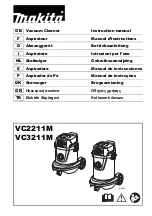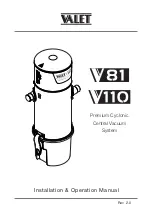
11
Remove the cap from the mounting port. You can place
the cap in multi hook while the hose is connected to the
tool.
(Fig. 16)
Insert the hose onto the mounting port of the tank and turn
it clockwise until it locks.
(Fig. 17)
OPERATION
WARNING:
• Always use a P2-respirator.
CAUTION:
• If foam or liquid escapes from the tool, switch off
immediately. Continuing to using in this condition may
cause an electric shock and breakage of the cleaner.
MAINTENANCE
WARNING:
• Always use a P2-respirator during performing
maintenance.
CAUTION:
• Always be sure that the tool is switched off and
unplugged before attempting to perform inspection or
maintenance.
• Never use gasoline, benzine, thinner, alcohol or the
like. Discoloration, deformation or cracks may result.
• A technical inspection, including inspection of filters, air
tightness, and control mechanism, must be performed
at least once a year by an instructed person.
• During maintenance, all contaminated items which
cannot be satisfactorily cleaned must be disposed.
Such items must be disposed of in impervious hags
which accord with your country’s regulations.
• After the operation in the hazardous area, the outside
of the tool must be decontaminated by vacuum
cleaning methods and wiped clean or treated with
sealant before you take the tool out of a hazardous
area. All the parts of the tool must be regarded as
contaminated when removed from the hazardous area,
and appropriate action must be taken to prevent dust
dispersal.
• Change the air filter when the air filter is clogged with
dust or you feel that the cleaner’s performance
declined.
• Check the filters periodically. If there is a tear on it,
replace it immediately.
Removing the air filter
CAUTION:
• Wait for about 5 minutes so that dust in the tank
completely settles down.
• Make sure that the tool is unplugged.
• Be careful not to let the dust enter inside the tank cover
when removing the air filter.
Unhook the tank cover and remove it carefully. Put it up
side down.
(Fig. 18)
Unlock the filter hooks by flipping the stopper lever.
(Fig. 19)
Cover the air filters with a plastic bag.
(Fig. 20)
Remove the air filters from the tank cover carefully and tie
the plastic bag firmly.
(Fig. 21)
Assembling the air filter
When you get the air filter components separately,
assemble them as follows.
Put the prefilter over the powder filter.
(Fig. 22)
Make sure that the borders of prefilter and powder filter
are set properly.
(Fig. 23)
Installing the air filter
Wipe off the seal face.
Set the new air filters and fix them with the filter hooks.
(Fig. 24)
Flip the stopper lever to lock the air filters.
Set the tank cover onto the tank and lock it with hooks.
(Fig. 25)
NOTICE:
• Make sure the hooks on the filters are set at the correct
position.
Cleaning the level sensors (Fig. 26)
The level sensors detect liquid when the tank becomes
full with liquid. Clean the level sensors with a soft cloth
from time to time when changing the air filters.
Cleaning the air filters
Clogged filter causes poor suction performance.
Clean out the filters from time to time.
To remove dust or particles adhering to the filters, remove
the prefilter from the air filter. And tap the prefilter several
times.
Occasionally wash the powder filter in water, rinse and dry
thoroughly in the shade before use. Never wash filters in a
washing machine.
(Fig. 27)
NOTE:
• Do not rub and scratch the powder filter, the prefilter, or
damper with hard objects such as a brush and a
paddle.
• The filters are consumable and are recommended to
have some spares for them.
Storage of power supply cord (Fig. 28
& 29)
Wind up the power supply cord around the multi-hook or
the base hook.
Storage of accessories
NOTE:
• Do not apply an excessive force to the accessories that
are held by the pipe holder. Applying an excessive
force to these accessories may cause damage to the
pipe holder.
Pipe rest can be used to store straight pipe, bent pipe and
others by just inserting these accessories.
(Fig. 30)
The pipes can be placed into the pipe holder when also
stopping using the cleaner on the way for a while.
(Fig. 31)
You can place the cap in multi hook while the hose is
connected to the tool.
(Fig. 32)
Storage of hose (Fig. 33 & 7)
The hose can be placed on either base hook or
multi-hook.












































